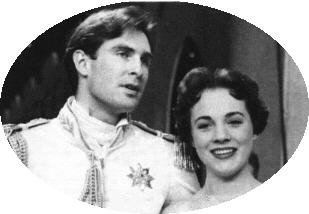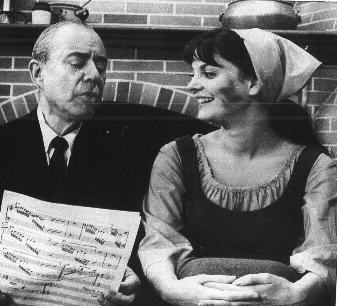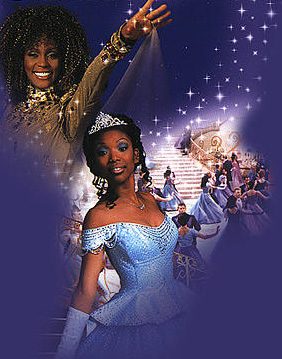Cinderella originates from one of the most famous folktales in the world, dating back to 9th-century China. The story, in all its various forms, featured a young woman who is rescued from a life of drudgery by her fairy godmother and eventually marries a handsome prince. The story exists in 500 versions in Europe alone, and was included by both Charles Perrault and the Grimm brothers in their collections of tales. The version with which most children (and the rest of us) are familiar is the one written by Frenchman Charles Perrault in 1729.
 In 1956 CBS-TV noted the tremendous success of NBC’s television production of Peter Pan, starring Mary Martin, and wondered if they might score with another popular tale; Cinderella. Unlike the television production of Peter Pan, which was adapted from the stage version of the show, CBS would create their fairy tale specifically for a televised broadcast. As luck would have it, an exciting young singer named Julie Andrews was then creating all sorts of buzz on Broadway as Eliza Doolittle in the musical My Fair Lady. When CBS approached Ms. Andrews about starring in their new venture she jumped at the chance.
In 1956 CBS-TV noted the tremendous success of NBC’s television production of Peter Pan, starring Mary Martin, and wondered if they might score with another popular tale; Cinderella. Unlike the television production of Peter Pan, which was adapted from the stage version of the show, CBS would create their fairy tale specifically for a televised broadcast. As luck would have it, an exciting young singer named Julie Andrews was then creating all sorts of buzz on Broadway as Eliza Doolittle in the musical My Fair Lady. When CBS approached Ms. Andrews about starring in their new venture she jumped at the chance.
Cinderella was the only musical written exclusively for television by the world famous musical team of Richard Rodgers & Oscar Hammerstein II. The partners were eager to sign on once they heard who had been cast in the lead. The chance to write for Julie Andrews sold them on the project. Attacking the project as if it were a Broadway show, they set to work and, within eight months, had produced a musical based on Charles Perrault’s version of the story. They wrote ten songs in all, including Ten Minutes Ago, one of Rodger's finest waltzes; the very funny Stepsister's Lament; My Own Little Corner, Do I Love You Because You're Beautiful?; and When You're Driving Through the Moonlight, all of which rank with Rodgers & Hammerstein’s best work. The show was broadcast live on CBS-TV on Sunday night March 31, 1957 and was viewed by the largest television audience to date of over 100 million people. It was seen live and in color on the East coast for those who had color televisions, and on the West coast a kinescope "copy" was broadcast three hours later.
 Rodgers & Hammerstein intended to present an expanded musical on stage the following season. That didn’t happen quite the way they had planned, but Cinderella did open in London in December 1958 as part of the city’s annual holiday celebration. Having been written by a superstar theatrical writing team, the musical moved easily to the stage and began opening in theaters across the US in 1961. It was so successful that Rodgers & Hammerstein decided to bring it back to television. Since the original had been done live, it had to be redone for the new broadcast. A new and equally stellar cast was assembled that included Ginger Rogers, Walter Pidgeon, Celeste Holm and featured an as-yet-unknown actress named Lesley Ann Warren. Richard Rodgers served as Executive Producer. First shown in February 1965, this restaged Cinderella was presented on CBS eight more times over the next 9 years. This version followed the original score with the exception of one added song for the Prince: “Loneliness of Evening”, which was originally written for South Pacific but did not survive the final cut.
Rodgers & Hammerstein intended to present an expanded musical on stage the following season. That didn’t happen quite the way they had planned, but Cinderella did open in London in December 1958 as part of the city’s annual holiday celebration. Having been written by a superstar theatrical writing team, the musical moved easily to the stage and began opening in theaters across the US in 1961. It was so successful that Rodgers & Hammerstein decided to bring it back to television. Since the original had been done live, it had to be redone for the new broadcast. A new and equally stellar cast was assembled that included Ginger Rogers, Walter Pidgeon, Celeste Holm and featured an as-yet-unknown actress named Lesley Ann Warren. Richard Rodgers served as Executive Producer. First shown in February 1965, this restaged Cinderella was presented on CBS eight more times over the next 9 years. This version followed the original score with the exception of one added song for the Prince: “Loneliness of Evening”, which was originally written for South Pacific but did not survive the final cut.
 In 1997 Disney waved its wand at yet another version of Rodgers & Hammerstein's Cinderella that featured an elegant interracial cast. This film starred such well-known names as Brandy, Whitney Houston, Whoopi Goldberg and Jason Alexander.
In 1997 Disney waved its wand at yet another version of Rodgers & Hammerstein's Cinderella that featured an elegant interracial cast. This film starred such well-known names as Brandy, Whitney Houston, Whoopi Goldberg and Jason Alexander.
The original 1957 kinescope of Rodgers & Hammerstein's Cinderella survives in the archives of the Museum of Television and Radio, and the 1965 remake can be seen frequently on cable television and is available on video and DVD. Cast recordings are available from both performances. Cinderella continues to enchant audiences on the stage as well. The New York City Opera presented versions in 1993 and 1995 and hundreds of productions of this well-loved story have been staged over the years by community and professional companies alike.
The Educational Theatre Collaborative was pleased to join these time honored efforts with its own staging of the classic tale when it presented Rodgers & Hammerstein’s Cinderella in the Silver Cultural Arts Center at Plymouth State University in January 2003.
